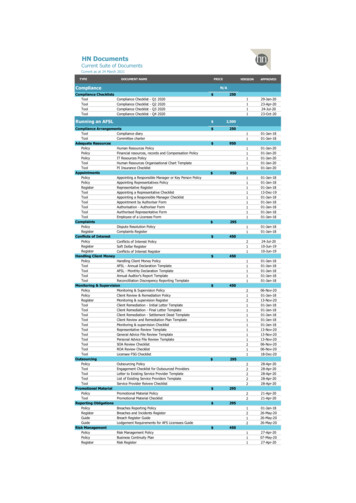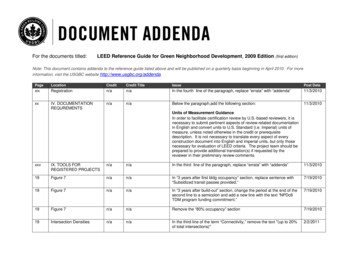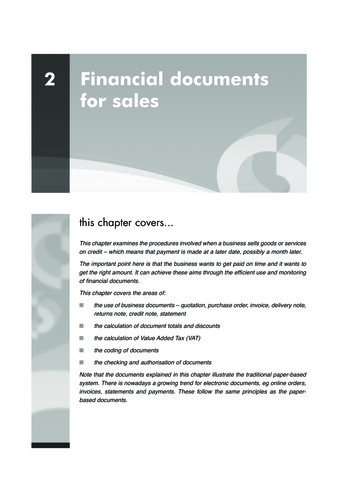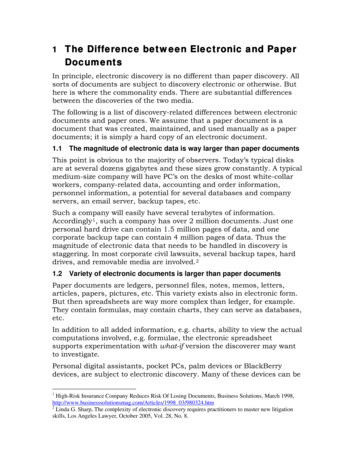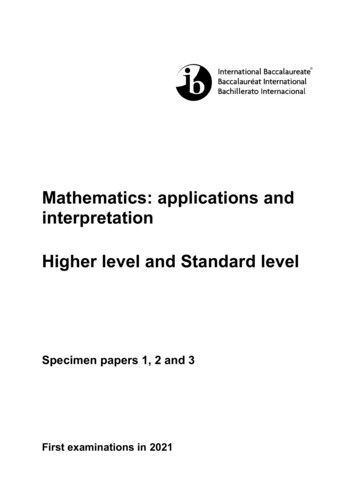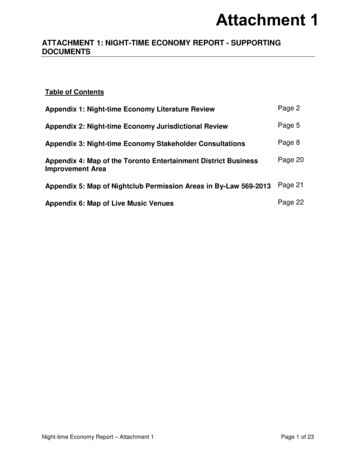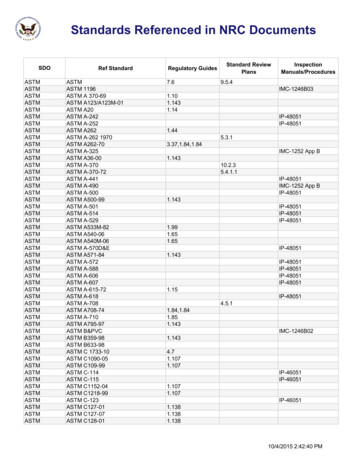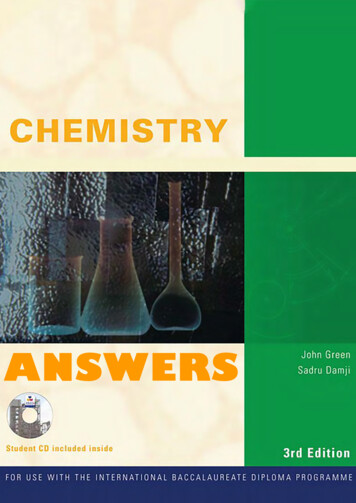
Transcription
ANSWERS
CHAPTER 1 QUANTITATIVE CHEMISTRYPage 4 Ex1.D2.C3.B4(a) element; (b) mixture; (c) compound; (d) element; (e) compound5.(a) mixture; (b) compound; (c) mixture; (d) element; (e) compound.Page 5 Ex 1.11.D2.C3.C4.D5.C6.D7.a) 0.20 b) 1.2 1023 c) 3.6 10238.a) 3.61x1024 b) 5.4x1023Page 7 Ex 1.21.D2.A3a) 127.9 b) 106.4 c) 132.1 d) 126.1 e) 152.0 f) 233.3Page 7 Ex 1.2.31.B2.D3.A4.B5.A6.a) 51.1 g, b) 7.47 g, c) 10.7 g, d) 68.7 g, e) 1.90 g7.a) 1.00, b) 3.00, c) 25.8, d) 5.448.a) 150 g mol-1, b) 128 g mol-19.1.245x1023 molecules10.a) 3.41x10-4, b) 5.68x10-3, c) 2.05x1022Page 12 Ex1.2.41.D2.C3.BPlease refer to the relevant chapter for more details. IBID Press 2007
CHAPTER 1 QUANTITATIVE CHEMISTRY4.D5.B6.C7.A8.B9.D10.B11.36.3%12.a) Fe2O3 b) SiF4 c) C2H2O413.SnO214.CuSO4.5H2O15.66700 g mol-116.K2Cr2O717.354.5; 47.4% carbon, 2.56% hydrogen, 50.0% chlorine18.a) 0.409 g carbon and 0.0453 g hydrogen b) 0.545 g oxygen c) C3H4O319.C2H5N3O2; C4H10N6O420.56.7%Page 14 Ex 1.31.A2.C3.D4.a) H2SO4, b) NaOH, c) HNO3, d) NH3, e) HCl,f) CH3COOH, g) CuSO4, h) CO, i) SO2, j) NaHCO35.a) NaCl b) CuS c) ZnSO4 d) Al2O3 e) Mg(NO3)2f) Ca3(PO4)2 g) HI h) (NH4)2CO3 i) CH4 j) PCl5Please refer to the relevant chapter for more details. IBID Press 2007
CHAPTER 1 QUANTITATIVE CHEMISTRYPage 17 Ex 1.3.11.C2.B3.A4.a)CaO 2 HNO3 Ca(NO3)2 H2Ob)2NH3 H2SO4 (NH4)2SO4c)2HCl ZnCO3 ZnCl2 H2O CO2d)SO2 2 Mg S 2MgOe)Fe3O4 4 H2 3Fe 4H2Of)2K 2C2H5OH 2KC2H5O H2g)2Fe(OH)3 Fe2O3 3H2Oh)CH3CO2H 2 O2 2CO2 2 H2Oi)2Pb(NO3)2 2PbO 4NO2 O2j)2NaMnO4 16HCl 2NaCl 2MnCl2 5Cl2 8H2Oa)CuCO3 CuO CO2b)NiO H2SO4 NiSO4 H2Oc)2 Fe 3 Br2 2 FeBr3d)PbO2 2 CO Pb 2 CO2e)2 FeCl2 Cl2 2 FeCl3f)C2H5OH 3 O2 2 CO2 3 H2Og)Ag 2 HNO3 AgNO3 NO2 H2Oh)MnO2 4HCl MnCl2 Cl2 2H2Oi)SO2 2H2S 3S 2H2Oj)4NH3 5O2 4NO 6H2O5.Page 19 Ex 1.41.C2.B3.a) 2 KClO3(s) 2 KCl(s) 3 O2(g)b) 0.4 molesc) 2.45 g4.37.69 g5.a) MnO2 ; Mn3O4,b) 3 MnO2 Mn3O4 O2,c) 0.353 gPlease refer to the relevant chapter for more details. IBID Press 2007
CHAPTER 1 QUANTITATIVE CHEMISTRYPage 21 Ex 1.4.11.a) Limiting reagent is Al, yield is 1.2 mol,b) Limiting reagent is I2, yield is 2.57 gc) 1.03 g excess aluminium2.a) Limiting reagent is SbF3, CCl4 is in excessb) 101.5 gc) 20.9 g3.a) Limiting reagent is salicylic acidb) 1.30 kgc) 90.6%Page 23 Ex 1.4.21.C2.D3.A4.B5.D6.30 cm3 of oxygen remains unreacted7.1.20 10238.46.8 g mol-19.0.761 g dm-310.2.24x105 dm3 (224 m3)Please refer to the relevant chapter for more details. IBID Press 2007
CHAPTER 1 QUANTITATIVE CHEMISTRYPage 25 Ex 1.4.31.A2.A3.C4.B5.D6.C7.a) 0.0139 moles, b) 83.2%8.a) 1100 dm3 b) 100 g (n.b. H2)9.Mass of gas in flask 4.685 g;Volume of flask (assuming density of water 1 kg dm-3) 0.8043 dm3;The flask contains 0.03193 moles at this T & P, hence the molar mass 146.7 gmol-1.10.The pressure in both flasks must be equal, thereforenRT x R 600 ( 2 – x ) R 3006P ---------- --------------------------- ----------------------------------------- 600x 600 – 300x x --VVV7Therefore there is 8/7 mol in the flask at 27 K and 6/7 mol in the flask at 127 K.6 8.31 400--nRT7P ---------- ----------------------------------- 570kPaV5Page 28 Ex 1.51.A2.D3.B4.a) 0.75 mol dm-3b) 0.0250 mol dm-3c) 0.0811 mol dm-35.a) 2.1 moles,b) 0.0020 moles,c ) 2.55x10-3 moles6.a) 0.4 dm-3 b) 2.94 dm-3 c) 0.720 dm-3 ( 720 cm-3)7.Weigh out precisely 2.922 g of solid sodium chloride (0.0500 moles) and make itup to 500 cm3 of solution in a 500 cm3 volumetric flask.8.Measure out 240 cm3 of 2.0 mol dm-3 hydrochloric acid (0.48 moles) and makethis up to 1.2 dm3 of solution.9.1.25 mol dm-310.[NO3–] 0.8 mol dm-3, [Cl–] 0 mol dm-3, [H ] 0.4 mol dm-3,[Pb2 ] 0.2 mol dm-3Please refer to the relevant chapter for more details. IBID Press 2007
CHAPTER 1 QUANTITATIVE CHEMISTRYPage 31 Ex 1.5.11.C2.A3.D4.a) 0.0125 moles, b) 0.0125 moles, c) 0.625 mol dm-35.a) 3.75x10-4 moles, b) 1.875x10-4 moles, c) 0.556 g dm-36.a) Ag (aq) Cl–(aq) AgCl(s), b) 4.00x10-3 moles, c) 2.00 10-3 moles,d) 90.66%7a) 5.01x10-4 moles, b) 2.51x10-3 moles, c) 0.711 g, d) 0.268 g, x 68a) 9.46 mol dm-3, b) 105.7 cm39a) 6 Fe2 (aq) Cr2O72–(aq) 14 H (aq) 6 Fe3 (aq) 2 Cr3 (aq) 7 H2O(l),b) 3.74x10-4 moles, c) 2.24 10-3 moles, d) 96.4%10.122 g mol-1, possibly benzoic acid (C6H5COOH)Page 33 Ex 1.5.21.a) 0.0050, b) 0.010, c) 0.005, d) 0.9 g, e) 90%2.82.6%. It was assumed that the impurities in the marble reacted with neither acidnor alkali. It was assumed that none of the evolved carbon dioxide remained insolution to react with the alkali.3.a) 12.0 g mol-1 b) 24.0 g mol-1 c) 36.0 g mol-1.Answer b) is most likely as this molar mass corresponds to magnesium, which isa divalent metal, rather than to carbon or chlorine.Page 35 Ex 1.5.31.C2.C3.A4.a) 4.376x105, b) 2.3x10-7, c) 4.15x108, d) 3.72x10-2, e) 4.768x102, f) 3.26x1005.a) 820000, b) 0.00629, c) 271 380 000 000, d) 0.0000002, e) 42, f) 0.589Page 36 Ex 1.161.B2.D3.B4.B5a) 0.028, b) 28, c) 3.76 105, d) 0.00175, e) 2x109Please refer to the relevant chapter for more details. IBID Press 2007
CHAPTER 2 ATOMIC STRUCTUREPage 50,51 Ex 2.11.D2.B3.C4.A5.C6.a) electron; b) neutron; c) electron; d) proton; e) electron7.8.a) Atoms that have the same atomic number (number of protons), but a differentnumber of neutrons (mass number).b) Mass numbers 10 and 11c) 10.89.The calcium phosphate, containing traces of the radioisotope, could be mixed intothe soil, in the same proportions for all the plants being tested. The radioactivityof the leaves of the plants could then be monitored and the rate of increase inradioactivity, as a result of the radioisotope, compared.10.therefore 72.5% 63Cu and 27.5% 65Cu11.12.Please refer to the relevant chapter for more details. IBID Press 2007
CHAPTER 2 ATOMIC STRUCTUREPage 54 Ex 2.21.a) They are bombarded with fast moving electrons.b) The paths of the moving ions are deflected by a magnetic field.c) They are collected on a metal plate and the current flowing to neutralise thecharge on the plate is recorded. (A number of other possible correct answers)2.A doubly charged germanium-70 would produce a peak at a mass of 35.4.Let % of 207Pb and 208Pb y, % of 206Pb (100-2y)206(100-2y) 207y 208y 207.2 x 1003y 20720-20600; y 120/3 4020% 206Pb, 40% 207Pb and 40% 208Pb.Page 59 Ex 2.31.C2.A3.D4.C5.C6.B7D8.a) 2,2b) 2,8,3c) 2,7d) 2,8,8e) 2,8,69.a) They are isotopes of the same element.b) Chemical properties depend primarily on the number of electrons that an atomhas and the nuclear charge affecting these. Both isotopes have the same numberof electrons and the same nuclear charge.10a) Because the electrons in the hydrogen atom can only have certain allowedenergies and light emission depends on transitions between these.b) The different series correspond to transitions to a given level from a higherlevel. The transition from the next higher level is the largest component of this,hence this dictates the spectral region it occurs in.c) As the allowed electron levels move to higher energy the difference in energyfrom the previous level becomes smaller, hence the difference in the frequenciesof the light emitted by successive transitions becomes smaller.Please refer to the relevant chapter for more details. IBID Press 2007
CHAPTER 2 ATOMIC STRUCTUREPage 67 Ex 12.11.C2.C3.B4.C5.B6.B7.C8.D9.a) 1s2 2s2 2p6 3s2 3p6 3d5 4s2b)1s2 2s2 2p6 3s2 3p4c)1s2 2s2 2p6d)1s2 2s2 2p6 3s2 3p6 3d5e)1s2 2s2 2p6 3s2 3p6 3d10 4s110.Na Li O N Ne11.a)b) Four electrons are lost relatively easily and they can be thought of as being inthe highest energy level. The next eight are rather more difficult to remove andthey may be thought of as being in the intermediate level. The remaining twoelectrons are very difficult to remove and can be thought of as forming the lowestenergy level.c) As successive electrons are removed, the electron–electron repulsion acting onthe remaining electrons, which to some extent counteracts the attractive force ofthe nucleus, decreases. This means that as more electrons are removed from anenergy level, (or as more electrons are removed, the remaining electrons are moreattracted to the nucleus) so that the energy required to remove the remainingelectrons increases.Please refer to the relevant chapter for more details. IBID Press 2007
CHAPTER 2 ATOMIC STRUCTURE12a) In both cases the effective nuclear charge acting on the outermost electron is 1. The electron being lost in sodium however is further from the nucleus and soless strongly held by electrostatic forces than the electron in lithium.b) In oxygen one of the 2p–orbitals is doubly filled. This means that there isincreased repulsion between the two electrons sharing the orbital. This increasedrepulsion more than offsets the effect of the increase in nuclear charge on goingfrom nitrogen to oxygen.c) In beryllium the electron lost comes from a 2s energy level, whereas in boronthe electron lost comes from a 2p orbital, which is at a higher energy than the 2s.This difference in energy of the 2s and 2p orbitals more than offsets the greaternuclear charge in boron.13.a) Vanadiumb) 1s2 2s2 2p6 3s2 3p6 3d3 4s2c) The electronic structure of the ion could not be that of an atom because the 3dlevel contains electrons, but there are no electrons in the 4s level. In neutralatoms electrons always at least partially fill the 4s before starting to fill the 3d.14.a) The element is aluminium. (It must be in group 3 because 3 electrons are easilylost before a sudden increase in IE, but it cannot be boron because it contains atleast 6 electrons.)b) About 4.4 (just slightly greater than that for the last electron shown.)c) They would be greater because even though the two elements have the sameeffective nuclear charge, the electrons being lost would be closer to the nucleusand hence more strongly attracted.15.a) B and Db) A – the first three electrons have much lower ionisation energies than thefourth.c) A and D or E and D.d) C – it has a high first ionisation energy and it must have more than fourelectrons in the outer shell as there is no sudden increase in ionisation energy.Please refer to the relevant chapter for more details. IBID Press 2007
CHAPTER 3 PERIODICITYPage 72 Ex 3.11.A2.C3.a) 7b) 2c) One of Na, Mg, Al, Si, P, S, Ard) One of F, Br, I, Ate) HalogensPage 75 Ex 3.21.C2.D3.D4.C5.Al, Mg, Ca, Ba, Cs6.a) Decrease–the valence shell electrons are further away from the charge on thenucleus.b) Decrease – the nuclear charge increases and valence electrons are in the samemain energy level thus pulling the valence electrons closer in.c) Increase – the increased electron–electron repulsion pushes the electronsfurther from the nucleus.d) Decrease – the valence electrons are further from the nucleus so are moreeasily lost.e) Decrease – the increasing nuclear charge attracts the valence electrons morestrongly.Page 80,81 Ex 3.31.C2.A3.B4.A5.A6.a) 2 Na 2 H2O 2 NaOH H2b) The sodium would fizz around on the surface as a molten blob, slowlydissolving.c) Redoxd) With lithium the reaction takes place gently and with potassium the reaction isso violent that the hydrogen ignites with a lilac flame.7.a) Purple b) White c) Black d) Yellow-brown e) YellowPlease refer to the relevant chapter for more details. IBID Press 2007
CHAPTER 3 PERIODICITY8.a) Ag (aq) Br–(aq) AgBr(s)b) Add aqueous lead nitrate. If I– is present a yellow precipitate forms. If Br– ispresent the precipitate will be white Pb2 (aq) 2I–(aq) PbI2 (s). Alternatively addchlorine water followed by an immiscible organic solvent (e.g. hexane) and if theorganic solvent turns purple as a result of iodine dissolving in it, I– is present Cl2––(aq) 2 I (aq) I2 (aq) 2Cl (aq). If Br– was present the bromine formed will turn theorganic layer brown Br2 (aq) 2 I–(aq) I2 (aq) 2 Br–(aq).9.a) Yes; the colourless (pale green solution) will turn yellow–brown;Cl2 2 Br– Br2 2 Cl–b) No reactionc) Yes; the yellow–brown solution will turn to another yellow–brown solutionand with excess bromine a black solid will form; Br2 2 I– I2 2 Br–d) No reaction10.a) Going from left to right the oxides change from basic to amphoteric to acidicin character.Acidic, SO2 (or SO3 or oxides of P): SO2 H2OHSO3– H Basic, Na2O (or MgO): Na2O H2O 2 Na 2 OH–b) The oxidising strength decreases going down the group. Going down thegroup the electron being gained is successively further away from the nucleus andhence are less strongly attracted.c) The reducing strength increases going down the group. Going down the groupthe electrons are successively further away from the nucleus and hence are moreeasily lost.Page 84 Ex 13.11.C2.B3.a) With sodium chloride there is no chemical reaction, the ions that exist in thesolid just become free to move. In the case of phosphorus trichloride, there is ahydrolysis reaction to produce a solution containing ions:PCl3 3H2O H3PO3 3H 3Clb)i) Add aqueous silver nitrate to both solutions and a white precipitatewould be formed in both cases.ii) Test both solutions with blue litmus paper. The solution formed fromthe phosphorus trichloride is acidic and will turn it red, but that from thesodium chloride is neutral and so will not affect it.4.Basic - Na2O or MgO. These react with acids, but not with bases, e.g.Na2O 2 HCl 2 NaCl H2O; MgO H2SO4 MgSO4 H2OAmphoteric-Al2O3. This reacts with both acids and bases, e.g.Al2O3 6 HCl 2 AlCl3 3 H2O & Al2O3 2 NaOH 3 H2O 2 NaAl(OH)4Acidic - P4O10, P4O6, SO2, or SO3. These dissolve in water to form acidicsolutions, e.g. P4O10 6 H2O 4 H 4 H2PO4–; SO2 H2OH HSO3–Please refer to the relevant chapter for more details. IBID Press 2007
CHAPTER 3 PERIODICITY5.The elements change from metallic (e.g. Na) to non–metallic (e.g. P) because asthe charge on the nucleus increases going from left to right across t
CHAPTER 1 QUANTITATIVE CHEMISTRY Please refer to the relevant chapter for more details. IBID Press 2007 Page 17 Ex 1.3.1 1. C 2. B
